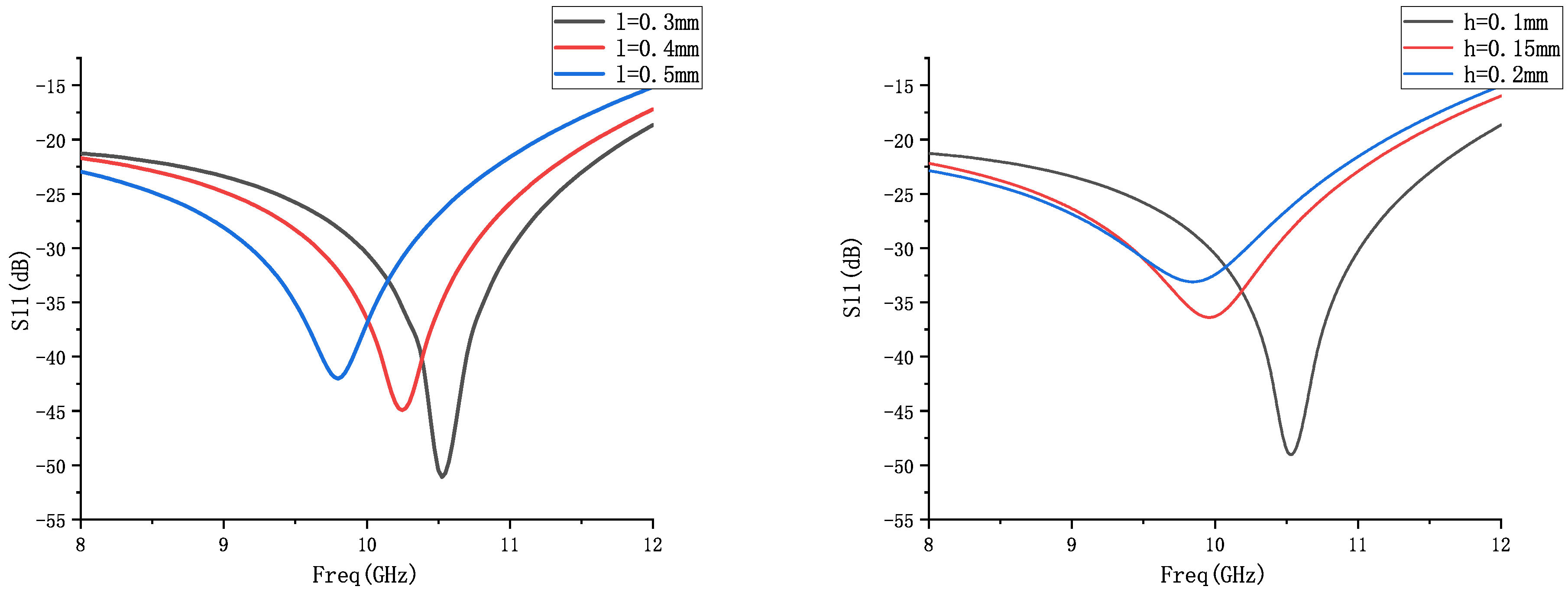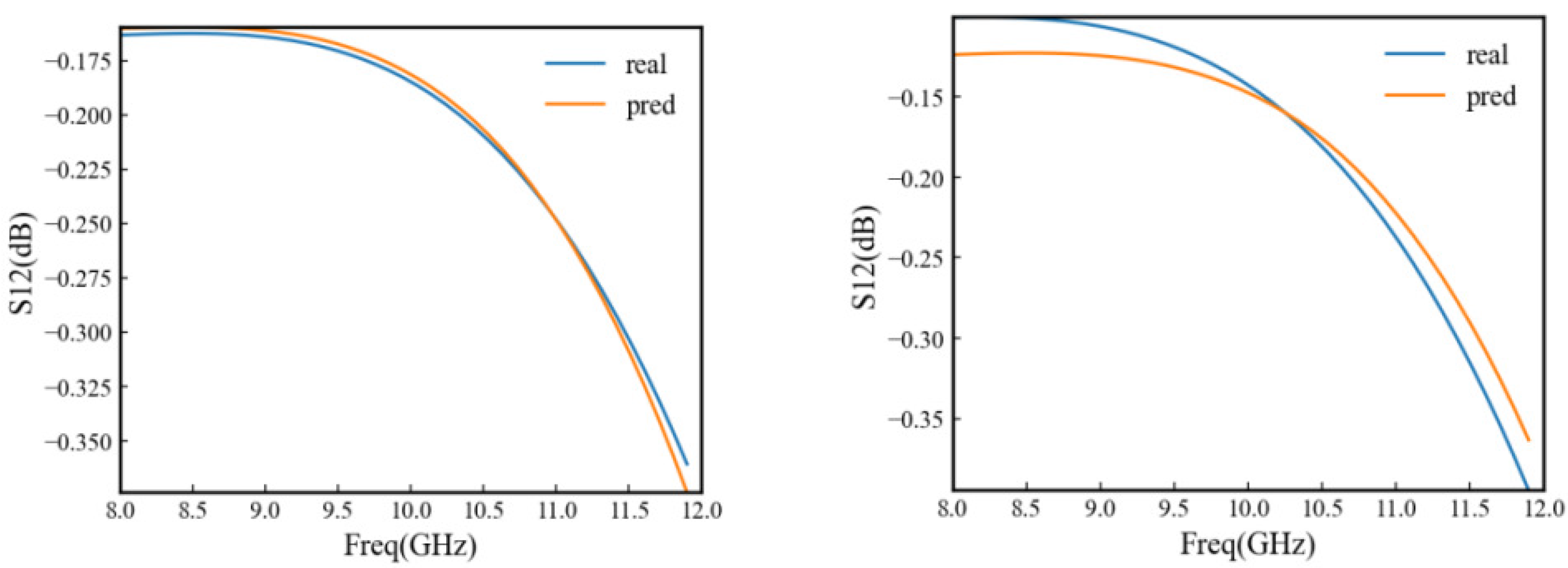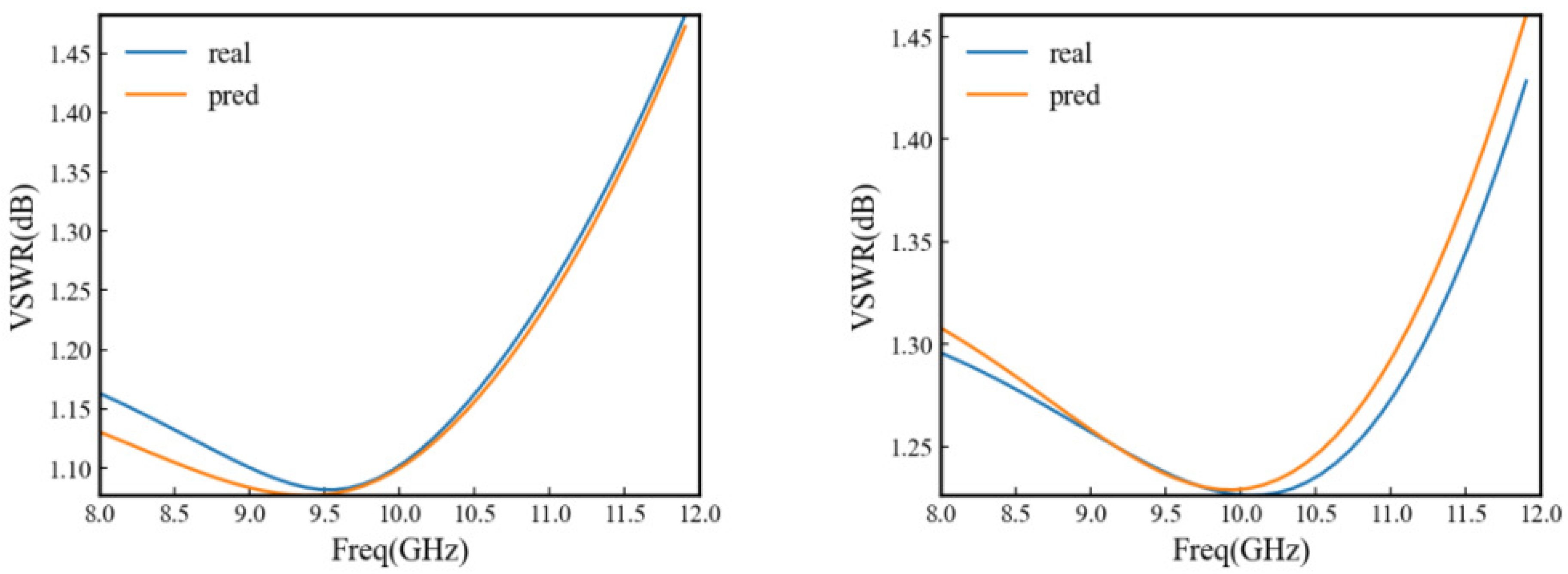Prediction of Microwave Characteristic Parameters Based on MMIC Gold Wire Bonding
Abstract
:1. Introduction
- 1.
- Construction of a model for gold wire bonding and continuous optimization of this model for data set acquisition and comparison of prediction results;
- 2.
- Designing a fully connected neural network model with a prediction accuracy generally better than the conventional model for the prediction of microwave transmission characteristics;
- 3.
- The experimental results show that our method achieves fast and accurate prediction compared with the simulation results of the model.
2. Model and Analysis
2.1. Construction of Gold Wire Bonding Model
2.2. Simulation Results and Analysis
3. Model and Analysis
3.1. Building an Artificial Neural Network
3.2. Experimental Results and Analysis
4. Conclusions
Author Contributions
Funding
Institutional Review Board Statement
Informed Consent Statement
Data Availability Statement
Conflicts of Interest
References
- Shi, J.; Liu, S.; Zhang, L.; Yang, B.; Shu, L.; Yang, Y.; Ren, M.; Wang, Y.; Chen, J.; Chen, W.; et al. Smart textile-integrated microelectronic systems for wearable applications. Adv. Mater. 2020, 32, 1901958. [Google Scholar]
- Park, J.; Kim, J.; Kim, S.Y.; Cheong, W.H.; Jang, J.; Park, Y.G.; Na, K.; Kim, Y.T.; Heo, J.H.; Lee, C.Y.; et al. Soft, smart contact lenses with integrations of wireless circuits, glucose sensors, and displays. Sci. Adv. 2018, 4, eaap9841. [Google Scholar] [CrossRef] [PubMed]
- Heck, M.J.; Bauters, J.F.; Davenport, M.L.; Doylend, J.K.; Jain, S.; Kurczveil, G.; Srinivasan, S.; Tang, Y.; Bowers, J.E. Hybrid silicon photonic integrated circuit technology. IEEE J. Sel. Top. Quantum Electron. 2012, 19, 6100117. [Google Scholar] [CrossRef]
- Tu, K.N.; Liu, Y. Recent advances on kinetic analysis of solder joint reactions in 3D IC packaging technology. Mater. Sci. Eng. R Rep. 2019, 136, 1–12. [Google Scholar]
- Aryan, P.; Sampath, S.; Sohn, H. An overview of non-destructive testing methods for integrated circuit packaging inspection. Sensors 2018, 18, 1981. [Google Scholar] [CrossRef]
- Zhan, D.; Lin, J.; Yang, X.; Huang, R.; Yi, K.; Liu, M.; Zheng, H.; Xiong, J.; Cai, N.; Wang, H.; et al. A Lightweight Method for Detecting IC Wire Bonding Defects in X-ray Images. Micromachines 2023, 14, 1119. [Google Scholar] [CrossRef] [PubMed]
- Tsai, T.N. A hybrid intelligent approach for optimizing the fine-pitch copper wire bonding process with multiple quality characteristics in IC assembly. J. Intell. Manuf. 2014, 25, 177–192. [Google Scholar]
- Wang, C.; Sun, R. The quality test of wire bonding. Mod. Appl. Sci. 2009, 3, 50–56. [Google Scholar] [CrossRef]
- Das, R.N.; Bolkhovsky, V.; Tolpygo, S.K.; Gouker, P.; Johnson, L.M.; Dauler, E.A.; Gouker, M.A. Large scale cryogenic integration approach for superconducting high-performance computing. In Proceedings of the 2017 IEEE 67th Electronic Components and Technology Conference (ECTC), Lake Buena Vista, FL, USA, 30 May–2 June 2017; IEEE: Piscataway Township, NJ, USA, 2017; pp. 675–683. [Google Scholar]
- Wu, P.; Yu, Z.; Liu, K.; Zhan, F.; Wang, S.; Wang, K.; Hao, C. Low-Profile and High-Integration Phased Array Antenna Technology. In Proceedings of the 2022 IEEE Conference on Antenna Measurements and Applications (CAMA), Guangzhou, China, 14–17 November 2022; IEEE: Piscataway Township, NJ, USA, 2022; pp. 1–6. [Google Scholar]
- Zhang, S.; Li, Z.; Zhou, H.; Li, R.; Wang, S.; Paik, K.W.; He, P. Recent Prospectives and Challenges of 3D Heterogeneous Integration. e-Prime-Adv. Electr. Eng. Electron. Energy 2022, 2, 100052. [Google Scholar]
- Lu, J.; Wang, W.; Wang, X.; Guo, Y. Active Array Antennas for High Resolution Microwave Imaging Radar; Springer Nature: Berlin/Heidelberg, Germany, 2023. [Google Scholar]
- Béjanin, J.; McConkey, T.; Rinehart, J.; Earnest, C.; McRae, C.; Shiri, D.; Bateman, J.; Rohanizadegan, Y.; Penava, B.; Breul, P.; et al. Three-dimensional wiring for extensible quantum computing: The quantum socket. Phys. Rev. Appl. 2016, 6, 044010. [Google Scholar] [CrossRef]
- Zhang, H.; Lan, Y.; Qiu, S.; Min, S.; Jang, H.; Park, J.; Gong, S.; Ma, Z. Flexible and stretchable microwave electronics: Past, present, and future perspective. Adv. Mater. Technol. 2021, 6, 2000759. [Google Scholar] [CrossRef]
- Kiang, J.F.; Chung, S.J.; Chen, H.H. Electrical Packaging for Microwave and Millimeter Wave Circuits. In Novel Technologies for Microwave and Millimeter—Wave Applications; Springer: Berlin/Heidelberg, Germany, 2004; pp. 545–562. [Google Scholar]
- Zhou, H.; Zhang, Y.; Cao, J.; Su, C.; Li, C.; Chang, A.; An, B. Research Progress on Bonding Wire for Microelectronic Packaging. Micromachines 2023, 14, 432. [Google Scholar] [PubMed]
- Li, J.; Wang, J.; Yi, X.; Liu, Z.; Wei, T.; Yan, J.; Xue, B.; Li, J.; Wang, J.; Yi, X.; et al. Packaging of Group-III Nitride LED. In III-Nitrides Light Emitting Diodes: Technology and Applications; Springer: Berlin/Heidelberg, Germany, 2020; pp. 185–202. [Google Scholar]
- Wang, T.; Harrington, R.F.; Mautz, J.R. Quasi-static analysis of a microstrip via through a hole in a ground plane. IEEE Trans. Microw. Theory Tech. 1988, 36, 1008–1013. [Google Scholar] [CrossRef]
- Pérez-Escribano, M.; Márquez-Segura, E. Parameters characterization of dielectric materials samples in microwave and millimeter-wave bands. IEEE Trans. Microw. Theory Tech. 2021, 69, 1723–1732. [Google Scholar] [CrossRef]
- Abdolrazzaghi, M.; Kazemi, N.; Nayyeri, V.; Martin, F. AI-Assisted Ultra-High-Sensitivity/Resolution Active-Coupled CSRR-Based Sensor with Embedded Selectivity. Sensors 2023, 23, 6236. [Google Scholar] [CrossRef]
- Li, J.; Wu, W.; Xue, D.; Gao, P. Multi-source deep transfer neural network algorithm. Sensors 2019, 19, 3992. [Google Scholar] [CrossRef] [PubMed]
- Kao, S.X.; Chien, C.F. Deep Learning Based Positioning Error Fault Diagnosis of Wire Bonding Equipment and an Empirical Study for IC Packaging. IEEE Trans. Semicond. Manuf. 2023. [Google Scholar] [CrossRef]
- Wu, H.; Chu, W. Machine learning assisted structural design optimization for flip chip packages. In Proceedings of the 2021 6th International Conference on Integrated Circuits and Microsystems (ICICM), Nanjing, China, 22–24 October 2021; IEEE: Piscataway Township, NJ, USA, 2021; pp. 132–136. [Google Scholar]
- Jin, H.; Gu, Z.M.; Tao, T.M.; Li, E. Hierarchical attention-based machine learning model for radiation prediction of wb-bga package. IEEE Trans. Electromagn. Compat. 2021, 63, 1972–1980. [Google Scholar] [CrossRef]
- Ahmed, O.; Thaher, R.H.; Ahmed, S.R. Design and fabrication of UWB microstrip Antenna on different substrates for wireless Communication system. In Proceedings of the 2022 International Congress on Human-Computer Interaction, Optimization and Robotic Applications (HORA), Ankara, Turkey, 9–11 June 2022; IEEE: Piscataway Township, NJ, USA, 2022; pp. 1–4. [Google Scholar]
- Saleh, S.; Ismail, W.; Abidin, I.S.Z.; Jamaluddin, M.H. 5G hairpin and interdigital bandpass filters. Int. J. Integr. Eng. 2020, 12, 71–79. [Google Scholar] [CrossRef]
- Zhao, Q.; Zhu, Q.; Yang, P.; Zhang, Z.; Luo, X.; Yan, Z. An Antenna Design of GNSS Terminal on B3 Frequency. In Proceedings of the 2023 2nd International Conference on Big Data, Information and Computer Network (BDICN), Xishuangbanna, China, 6–8 January 2023; IEEE: Piscataway Township, NJ, USA, 2023; pp. 130–133. [Google Scholar]
- Loracher, S.; Blau, K.; Stehr, U.; Stephan, R.; Hein, M. Experimental proof-of-principle of a passive, nearly reciprocal, transistor-based tuneable RF inductance. In Proceedings of the 2016 46th European Microwave Conference (EuMC), London, UK, 4–6 October 2016; IEEE: Piscataway Township, NJ, USA, 2016; pp. 1055–1058. [Google Scholar]
- Nikolaou, S.; Davidovic, M.; Nikolić, M.; Vryonides, P. Resonator type and positioning study for the creation of a potentially reconfigurable frequency notch in a UWB antenna return loss. In Proceedings of the 5th European Conference on Antennas and Propagation (EUCAP), Rome, Italy, 11–15 April 2011; IEEE: Piscataway Township, NJ, USA, 2011; pp. 350–353. [Google Scholar]
- Belevitch, V. Topics in the design of insertion loss filters. IRE Trans. Circuit Theory 1955, 2, 337–346. [Google Scholar] [CrossRef]
- Rizk, M.R.; Abou-Bakr, E.; Nasser, A.; El-Badawy, E.S.A.; Mahros, A.M. On the investigation of voltage standing wave ratio to design a low noise wideband microwave amplifier. In Proceedings of the 2016 Eighth International Conference on Ubiquitous and Future Networks (ICUFN), Vienna, Austria, 5–8 July 2016; IEEE: Piscataway Township, NJ, USA, 2016; pp. 568–572. [Google Scholar]
- Prieto, A.; Prieto, B.; Ortigosa, E.M.; Ros, E.; Pelayo, F.; Ortega, J.; Rojas, I. Neural networks: An overview of early research, current frameworks and new challenges. Neurocomputing 2016, 214, 242–268. [Google Scholar]
- Picard, R.R.; Cook, R.D. Cross-validation of regression models. J. Am. Stat. Assoc. 1984, 79, 575–583. [Google Scholar] [CrossRef]











| Parameter Name | h | l | w1 | w2 | w3 | w4 |
|---|---|---|---|---|---|---|
| Minimum value | 0.1 mm | 0.3 mm | 1.841 mm | 0.192 mm | 1.593 mm | 0.267 mm |
| Maximum value | 0.2 mm | 0.6 mm | 2.241 mm | 0.392 mm | 1.993 mm | 0.667 mm |
| Spacing | 0.05 mm | 0.05 mm | 0.1 mm | 0.05 mm | 0.1 mm | 0.1 mm |
| Name | Input | h1 | h2 | h3 | h4 | h5 | h6 | Output |
|---|---|---|---|---|---|---|---|---|
| Number of neurons | 6 | 20 | 50 | 100 | 400 | 400 | 200 | 123 |
| Activation function | ReLU | ReLU | ReLU | ReLU | ReLU | ReLU | ReLU | × |
| BN | × | × | × | ✓ | ✓ | ✓ | ✓ | × |
| Dropout | × | × | × | × | × | × | ✓ | × |
Disclaimer/Publisher’s Note: The statements, opinions and data contained in all publications are solely those of the individual author(s) and contributor(s) and not of MDPI and/or the editor(s). MDPI and/or the editor(s) disclaim responsibility for any injury to people or property resulting from any ideas, methods, instructions or products referred to in the content. |
© 2023 by the authors. Licensee MDPI, Basel, Switzerland. This article is an open access article distributed under the terms and conditions of the Creative Commons Attribution (CC BY) license (https://creativecommons.org/licenses/by/4.0/).
Share and Cite
Yu, S.; Li, H. Prediction of Microwave Characteristic Parameters Based on MMIC Gold Wire Bonding. Appl. Sci. 2023, 13, 9631. https://doi.org/10.3390/app13179631
Yu S, Li H. Prediction of Microwave Characteristic Parameters Based on MMIC Gold Wire Bonding. Applied Sciences. 2023; 13(17):9631. https://doi.org/10.3390/app13179631
Chicago/Turabian StyleYu, Shenglin, and Hao Li. 2023. "Prediction of Microwave Characteristic Parameters Based on MMIC Gold Wire Bonding" Applied Sciences 13, no. 17: 9631. https://doi.org/10.3390/app13179631




